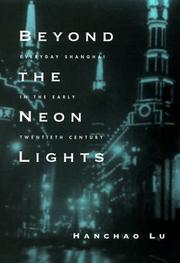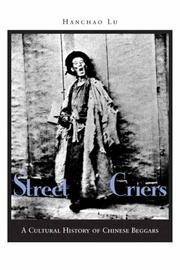| Listing 1 - 8 of 8 |
Sort by
|

ISBN: 0520215648 Year: 1999 Publisher: Berkeley Los Angeles London University of California Press
Abstract | Keywords | Export | Availability | Bookmark
 Loading...
Loading...Choose an application
- Reference Manager
- EndNote
- RefWorks (Direct export to RefWorks)
S03/0633 --- S11/0470 --- China: Geography, description and travel--Shanghai (incl. concessions) --- China: Social sciences--Cities: since 1949 --- Shanghai (China) --- -Shanghai (China) --- -Economic conditions --- -Social conditions --- -Social life and customs --- -S03/0633 --- -Shanghai --- Changhaï (China) --- Shang-hai (China) --- Shang hai shi (China) --- Shanghai Shi (China) --- Shanghai Municipality (China) --- Shanghai Shi ren min zheng fu (China) --- Shankhaĭ (China) --- Xangai (China) --- 上海 (China) --- Ṣămhayi (China) --- Economic conditions --- Shanghai --- Social conditions --- Social life and customs --- 20th century --- Chang-hai (China) --- Schanghai (China) --- 上海市(China) --- 上海市人民政府 (China) --- Шанхай (China) --- Śangqai (China)

ISBN: 052093167X 0585288984 9780520931671 9780585288987 0520215648 9780520215641 0520243781 9780520243781 Year: 1999 Publisher: Berkeley ; Los Angeles, California : University of California Press,
Abstract | Keywords | Export | Availability | Bookmark
 Loading...
Loading...Choose an application
- Reference Manager
- EndNote
- RefWorks (Direct export to RefWorks)
"How did ordinary people live through the extraordinary changes that swept across modern China? How did the "little people" cope with the epic upheavals that shook their lives? How did peasants transform themselves into urbanites? In this carefully researched study, Hanchao Lu weaves rich documentary data with ethnographic surveys and interviews to reconstruct the fabric of everyday life in China's largest and most complex city in the first half of this century."--Jacket. "Today, in the post-Mao, post-Deng era, China faces a vigorous resurgence of paradoxes similar to those that surfaced at the end of the imperial era. At the same time, the pragmatism of the Chinese people endures, suggesting that the lessons of the past have broad implications for urban China and urban-rural relations in China at the beginning of the third millennium."--Jacket.
Regions & Countries - Asia & the Middle East --- History & Archaeology --- East Asia --- Shanghai (China) --- Changhaï (China) --- Ṣămhayi (China) --- Shang-hai (China) --- Shang hai shi (China) --- Shanghai --- Shanghai Municipality (China) --- Shanghai Shi (China) --- Shanghai Shi ren min zheng fu (China) --- Shankhaĭ (China) --- Xangai (China) --- 上海 (China) --- Social life and customs --- Social conditions --- Economic conditions --- Chang-hai (China) --- Schanghai (China) --- 上海市(China) --- 上海市人民政府 (China) --- Шанхай (China) --- Śangqai (China) --- Economic history.
Book
ISBN: 1009191152 1009191160 1009180975 1009180983 9781009191159 9781009191166 9781009180979 Year: 2023 Publisher: Cambridge, England : Cambridge University Press,
Abstract | Keywords | Export | Availability | Bookmark
 Loading...
Loading...Choose an application
- Reference Manager
- EndNote
- RefWorks (Direct export to RefWorks)
Shanghai Tai Chi offers a masterful portrait of daily urban life under socialism in a rich social and political history of one of the world's most complex cities. Hanchao Lu explores the lives of people from all areas of society - from capitalists and bourgeois intellectuals to women and youth. Utilizing the metaphor of Tai Chi, he reveals how people in Shanghai experienced and adapted to a new Maoist political culture from 1949. Exploring the multifaceted complexity of everyday life and material culture in Mao's China, Lu addresses the survival of old bourgeois lifestyles under the new proletarian dictatorship, the achievements of intellectuals in an age of anti-intellectualism, the pleasure that urban youth derived from reading taboo literature, the emergence of women's liberation and the politics of greening and horticulture. This captivating, epitomizing, and vivid history transports readers to history as lived on Shanghai's streets and back alleyways.
City and town life --- Mao, Zedong, --- Influence. --- Shanghai (China) --- History --- Politics and government --- City life --- Town life --- Urban life --- Sociology, Urban --- Mao, Zedong --- Mao Tse-Toung --- Mao Tsetoeng --- Mao Tsetoung --- Mao Tsetung --- Mao, Tse-Toung --- Mao, Tsé toung --- Mao, Tse-Tung --- Mau Tse-Toeng --- Mao, Ze dong --- 毛泽东 --- 毛澤東 --- Chang-hai (China) --- Changhaï (China) --- Ṣămhayi (China) --- Shang-hai (China) --- Shang hai shi (China) --- Shanghai --- Shanghai Municipality (China) --- Shanghai Shi (China) --- Shanghai Shi ren min zheng fu (China) --- Shankhaĭ (China) --- Xangai (China) --- 上海 (China) --- Schanghai (China) --- 上海市(China) --- 上海市人民政府 (China) --- Шанхай (China) --- Śangqai (China)

ISBN: 080475148X Year: 2005 Publisher: Stanford Stanford university press
Abstract | Keywords | Export | Availability | Bookmark
 Loading...
Loading...Choose an application
- Reference Manager
- EndNote
- RefWorks (Direct export to RefWorks)
Beggars --- History --- China --- Social conditions
Book
ISBN: 9780295989402 Year: 2010 Publisher: Seattle University of Washington press
Abstract | Keywords | Export | Availability | Bookmark
 Loading...
Loading...Choose an application
- Reference Manager
- EndNote
- RefWorks (Direct export to RefWorks)
Stafford, Francis E., --- Travel --- China --- Shanghai (China) --- Wuchang Qu (Wuhan Shi, China) --- History, Local --- History --- Social aspects --- Social life and customs
Book
ISBN: 0295806907 0295989408 9780295806907 Year: 2010 Publisher: Seattle : University of Washington Press,
Abstract | Keywords | Export | Availability | Bookmark
 Loading...
Loading...Choose an application
- Reference Manager
- EndNote
- RefWorks (Direct export to RefWorks)
China's 1911 Revolution ended the rule of both the 267-year-old Manchu Qing dynasty and the more than 2, 000-year-old imperial system, establishing Asia's first, if not lasting, republic. Because war correspondence was not an established profession in China and the camera was a rare apparatus in Chinese life at the time, photographs of the revolution are rare. Francis E. Stafford (1884-1938), an American working as a photographer for Asia's largest publishing company, Commercial Press in Shanghai, had unusual access to both sides of the conflict. The Birth of a Republic documents this tumultuous period through Stafford's photographic eye. Stafford trained his lens on the leaders of the revolutionaries, the imperial court, and the generals and foot soldiers, as well as on the common people. His images thus capture the stock in trade of war correspondents and photo journalists, but he also documented scenes of everyday life, from the streets of China's cities to the muddy lanes of its villages, from paddy rice fields to factory workshops, from open-air food markets to the inner chambers of Buddhist temples and Christian churches. His remarkable photographs reveal sweeping social and political change, as well as the tenacity of tradition. The 162 photographs presented here are from the collection of Stafford's grandson, Ronald Anderson, and are set in historical and cultural context through an interpretive introduction and extensive captions. This book will appeal to historians and general readers interested in modern China, revolution, and war.
Stafford, Francis E., --- Travel --- China --- Shanghai (China) --- Wuchang Qu (Wuhan Shi, China) --- History, Local --- History --- Social life and customs --- Social aspects
Book

ISBN: 9780674054820 Year: 2010 Publisher: Cambridge, MA
Abstract | Keywords | Export | Availability | Bookmark
 Loading...
Loading...Choose an application
- Reference Manager
- EndNote
- RefWorks (Direct export to RefWorks)
Digital

ISBN: 9780674054820 Year: 2010 Publisher: Cambridge, Mass. Harvard University Press
Abstract | Keywords | Export | Availability | Bookmark
 Loading...
Loading...Choose an application
- Reference Manager
- EndNote
- RefWorks (Direct export to RefWorks)
| Listing 1 - 8 of 8 |
Sort by
|

 Search
Search Feedback
Feedback About UniCat
About UniCat  Help
Help News
News